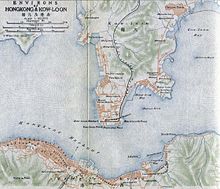Kowloon Walled City
Kowloon Walled City ( Chinese 九龍 寨 城 / 九龙 寨 城 , Pinyin Jiǔlóng Zhàichéng , Jyutping Gau 2 lung 4 Zaai 6 Sing 4 , cant.九龍 城寨 / 九龙 城寨Pinyin Jiǔlóng Chéngzhài Jyutping Gau 2 lung 4 Sing. 4 zaai 6 ) war a district in Hong Kong on the Kowloon Peninsula with a long-standing unclear legal status. With 1.3 million inhabitants per square kilometer, it was the place with the highest population density in the world. In 1987, 33,000 people lived in an area of just under 0.027 km². Colloquially, it was also Walled City (dt. Walled city ) called or on Cantonese as Hak Ngam zi Sing ( 黑暗之城 , Hēi'àn zhī Chéng , Jyutping Hak 1 ngam 3 zi 1 Sing 4 ), the city of darkness, designated .
Originally, the Walled City was a military outpost ( 寨 , zhài - "fortified outpost") of the Chinese . After the New Territories were leased from Great Britain in 1898 , the Walled City became a Chinese enclave . After the Japanese occupation of Hong Kong ended in World War II , many Chinese refugees found cheap housing here and the population began to grow dramatically. The Walled City was uncontrolled and densely built with up to 14-story high-rise buildings. The apartments were on average around 20 m² and were mostly inhabited by whole families. There were shops, schools, small craft shops and unlicensed dental offices . The district was also the center of drug trafficking and prostitution . The complex was controlled by the triads . After several years of evacuation, the Walled City was demolished from 1993 to 1994. At the end of 1995, the Kowloon Walled City Park was opened on the square , a city park designed in the style of a garden from the early Qing dynasty .
history
Chinese military post
The area of what will later become the Walled City was originally a Chinese military post with initially 30 soldiers in 1668, then from 1682 to 1811 with around ten guards. In 1810 the Kowloon Fort was built with a crew of 48 soldiers.
In 1847, after Hong Kong Island was ceded to Great Britain in the Treaty of Nanking , it was converted into a fortified with strong walls. When the colonial power leased the New Territories, including the Kowloon Peninsula, for 99 years in 1898, the fort was excluded and became a Chinese exclave . However, the Chinese government hardly used the outpost. Although the British Crown Colony began to regard the area as their territory, apart from the establishment of some ecclesiastical charities, it was also largely ignored by the British and slowly deteriorated. During the Japanese occupation of Hong Kong in World War II , the occupiers tore down the remaining walls in order to expand Kai Tak Airport with the stones .
Uncontrolled settlement
After the end of the occupation, the People's Republic of China declared its intention to actively use the exclave again. This caused the population to grow rapidly, and by 1947 there were about 2,000 people living in the area. However, the declaration of intent was not followed by any action. The British, too, now pursued a policy of non-interference in almost all affairs of the Walled City, making it an almost law-free zone. As a result, this area was soon under the control of the triads , organized crime . Since no taxes were collected and the rents were low, the population continued to rise and numerous small businesses emerged. The available space was expanded in the following decades through ever denser and higher buildings. However, the buildings were completely unplanned, which ultimately led to the characteristic appearance of a "human anthill". During this time, the Walled City was seen as the focal point of organized crime, in which the police only dared to venture into extreme cases and only in larger groups. It was not until the mid-1970s that the Hong Kong government decided to take action and carried out thousands of raids, which further weakened the power of the triads. In 1983, the Kowloon Police Chief declared that crime was now under control. Nevertheless, the Walled City was considered an eyesore with a low standard of living and poor hygiene.
Eviction and demolition
Over time, both the British and Chinese governments realized that the situation in the area was becoming increasingly intolerable, despite reports of low crime rates. Compared to the other districts of Hong Kong, the quality of life in the Walled City was far lower, especially the sanitary situation was unacceptable. Therefore, a special committee in Hong Kong drafted a plan to redesign the district. In 1987 it was decided to vacate the area, demolish all buildings and create a park instead. Hong Kong paid HK $ 2.7 billion ( US $ 350 million ) in compensation to residents. Still, some residents refused to leave the Walled City. They were evicted between November 1991 and July 1992. After four months of planning, the demolition began on March 23, 1993 and was completed in April 1994. Construction work on the redesign of the Kowloon Walled City Park ( 九龍 寨 城九龙 / 九龙 寨 城 公园 ) began in May 1994 and opened in December 1995. The park houses a museum on the history of the Walled City including some historical artifacts and parts of the building that came to light during the demolition. In addition to the archaeological ruins in the park, a historical reconstruction of the yamen was rebuilt as an accessible building with two historical cannons from the archaeological finds that were discovered during the construction phase of the park.
Development
The original military fort comprised a roughly rectangular area 213 meters long and 126 meters wide, surrounded by a four to six meter high wall. Access was possible through four main gates, which were about half the height of the wall and could be locked with iron doors. The south gate served as the main entrance; there was a landing stage on the nearby Lung Chun River. There was a yamen in the middle . This administration building was preserved even after the wall was torn down in World War II and was integrated into the emerging settlement, which soon took up the entire site. As the population continued to grow, the buildings were continuously increased or replaced by high-rise buildings until the entire block of houses with more than 300 up to 14-story high-rise buildings was densely built up. The only exception was a courtyard with the yamen, which served as a community center. In total, the complex comprised more than 500 buildings.
Instead of streets, there were only very narrow corridors lined with rubbish between the individual buildings. The rooms below received hardly any daylight. Countless corridors, walkways and stairs made it possible to cross the Walled City even on higher levels, so that one can also speak of a single, huge building complex. Due to the close development, it was still possible to move between different buildings on the roofs. The supply of drinking water and electricity as well as the sewage disposal were not guaranteed in many parts.
Residents
Up until the Second World War, the Walled City area never had more than a few hundred people. The dense development with high-rise buildings with 10 or even 14 floors as well as the cramped conditions - the apartments were mostly barely larger than 20 m² and were inhabited by whole families - led to an extremely high population density over time. Due to the special legal situation, however, no reliable figures were collected for a long time.
Official estimates of the population were 10,004 in 1971 and 14,617 in 1981, but these numbers are far too low. Unofficial estimates, however, often include the neighboring settlement of Sai Tau Tsuen. A study carried out in advance of the demolition in 1987 showed a population of around 33,000 and is considered the most reliable figure. This results in a population density of over 1.3 million inhabitants per square kilometer in the area of just 0.025 square kilometers. For comparison: the Principality of Monaco had a population density of almost 17,000 inhabitants / km² in 2009, making it the most densely populated nation state in the world - the population is also 33,000, but is spread over almost a hundred times the area. With a population density of 1.3 million inhabitants per square kilometer, the total world population of around 7.1 billion people would have space in an area of around 5500 square kilometers, which is slightly more than twice the area of Luxembourg .
The life of the residents of Kowloon Walled City was similar to that of other Hong Kong residents. The roofs of the buildings served as meeting points. Here the residents could relax and their children could play. The Yamen in the heart of the city was an important social center. Here courses could be taken and also watched TV. Christian and other religious gatherings were also held in the yamen. The Tin Hau and Fuk Tak temples were meeting places for Buddhists and Taoists as well as for followers of animistic religions.
literature
- Jackie Pullinger, Andrew Quicke: Light in Hell's Courtyard . Lüdenscheid, 2008, ISBN 978-3-940188-03-8 .
- Ian Lambot, Greg Girard: City of Darkness: Life in Kowloon Walled City . Watermark, 1993, ISBN 1-873200-13-7 .
- Ryuji Miyamoto: Kowloon Walled City . Heibonsha, 1997, ISBN 978-4-582-27736-4 .
- Ryan Graudin: Walled City . Rowohlt Taschenbuch Verlag, 2015, ISBN 978-3-499-21705-0 .
Web links
- Oliver Klatt Forgotten City Hak Nam - Fortress of Darkness , Spiegel Online .
- Anja Krieger The last labyrinth
- Hugo Portisch . Television documentary (ORF) Kowloon Walled City (1988) Youtube
Individual evidence
- ^ A b John Carney: Kowloon Walled City: Life in the City of Darkness . In: South China Morning Post , March 16, 2013. Retrieved February 28, 2016.
- ^ Term "zhai (寨)". In: www.zdic.net. Retrieved May 3, 2017 (Chinese, German, English).
- ↑ Oliver Klatt: Forgotten City Hak Nam. Fortress of darkness . In: Spiegel Online , March 22, 2010. Retrieved November 3, 2013.
- ^ A b c Anthony KK Siu: The Kowloon Walled City (= Journal of the Royal Asiatic Society Hong Kong Branch . Volume 20 ). 1980, ISSN 1991-7295 , pp. 139–141 (English, scan [PDF; accessed November 7, 2018]).
- ↑ HK Leisure and Cultural Service Department (香港 康樂 及 文化 事務 署): Kowloon Walled City Park (九龍 寨 城 公園 / 九龙 寨 城 公园). In: www.lcsd.gov.hk. Retrieved May 3, 2017 (Chinese, English).
- ↑ The Hong Kong Tourism Board, short: HKTB (香港 旅遊 發展 局 / 香港 旅游 发展 局): Kowloon Walled City Park (九龍 寨 城 公園 / 九龙 寨 城 公园). In: www.discoverhongkong.com. Retrieved on May 3, 2017 (German, English).
- ↑ Pamela Owen: Inside the Kowloon Walled City… . In: Mail online , May 5, 2012. Retrieved August 30, 2014.
- ^ Charles Goddard: The Clearance . In: City of Darkness: Life in Kowloon Walled City , pp. 208-211.
Coordinates: 22 ° 19 ′ 55 ″ N , 114 ° 11 ′ 26 ″ E





